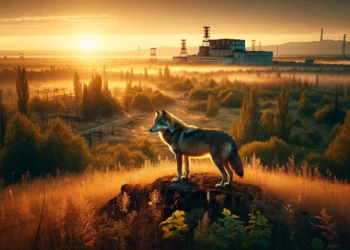A river running past the Chernobyl nuclear reactor is currently being dredged to create a 2,000-kilometer shipping route linking the Baltic and Black seas. The project was widely questioned by scientists and conservationists, who claim radioactive sludge from the 1986 nuclear disaster could resurface due to the work.

The waterway would go from Gdańsk in Poland, through southern Belarus to Kherson in Ukraine. It would be Europe’s longest waterway, stretching 25 times the length of the Panama Canal. Government ministries and a coalition of organizations are pushing through the construction. Small vessels can already pass through it.
The project involves the dredging of the entire Pripyat river, which serpents within 2.5 kilometers of the Chernobyl nuclear reactor. The river has already been dredged in at least seven places, five of which are just 10 kilometers from the reactor, according to the Save Polesia coalition, which groups NGOs against the project.
Polesia, an area in Eastern Europe often called ‘Europe’s Amazon’ is host to the continent’s largest wetland wilderness and home to endangered European wildlife. The dredging would also affect the most sensitive parts of Polesia and change the areas’ flood regime, the coalition argues. The waterway would dry up drivers, damage landscapes, impact wildlife, and destroy the livelihoods of local communities.
The Pripyat River is one of most pristine waterways in Europe and is an integral part of the biodiversity of Polesia. More than 90% of all birds in Belarus are found in Polesia and there are a number of unique ecosystems, black alder forests. Birdlife and WWF estimate 12 wildlife reserves would be affected by the waterway.
The dredging also goes against recommendations from the International Atomic Energy Association (IAEA) to keep the Chernobyl exclusion zone undisturbed because of the contamination from the explosion. In 1986, a blast occurred on one of the reactors in the Chernobyl nuclear power plant, leading to the nuclear disaster.
A study by the French organization ACRO showed 28 million people downstream who depend on the Dnieper River for water and food could be at increased radiation risk. Pripyat River and the Kyiv artificial lake will become ongoing sources of radioactive contaminants as annual dredging will be needed for the operation of the waterway.
“Constructing the E40 will have a radiological impact on the construction workers and the population depending on the rivers. The IAEA recommends to leave the contaminated sediments in the Kyiv reservoir in place, to avoid exposure of the population downstream. In this context the construction of the E40 is not feasible,” ACRO said in a statement.
The Ukrainian government commissioned the dredging work of the Polish section of the river for almost $430 million to the company Sobi, which started work in July. A feasibility study was jointly commissioned by the government and the company but NGOs said it was incomplete and it didn’t include an environmental analysis.
The study failed to properly analyze the implications of radioactive contamination from dredging inside the exclusion zone, which is 100km upstream, they argued. Public participation wasn’t allowed, and alternatives to meet the strategic objective of better freight connections between the Black and Baltic Seas weren’t explored.
Dmitrij Nadeev, a manager at Sobi, told The Guardian the company commissioned research on radiation and took soil samples. The study showed the work “can be done safely” and workers were provided with personal protective equipment. Still, Nadeev declined to share the radiation study.
The NGOs against the project argue that the transport of goods using the waterway would be “slower, more expensive, more polluting, and less reliable” than electric rail. They acknowledge Ukraine needs better transportation links with other countries but claim the priority should be to invest in the existing railway network.
Ariel Brunner, Birdlife International’s Senior Head of Policy for Europe and Central Asia, said in a statement: “Digging up radioactive material and sending it down the river into heavily populated areas is irresponsible. Indeed the entire E40 is an ill-conceived and potentially devastating project that is being pushed forward.”






